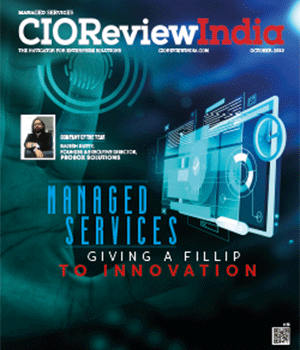
Low-CodeNo-Code: The Key to Intelligent Automation and Agile Business Management
Sachin Panicker, Chief AI Officer, Fulcrum Digital
 As the relentless wave of digital transformation continues its sweep across sectors, streamlining processes for enhanced efficiency and cost-savings has increasingly become a business imperative. It is in this context that the adoption of low-code/no-code (LCNC) technology has emerged as a significant trend in the arena of business process management. Gartner estimates that by 2025, 70% of new applications developed by organizations will leverage LCNC technologies, a meteoric rise from 25% in 2020.
As the relentless wave of digital transformation continues its sweep across sectors, streamlining processes for enhanced efficiency and cost-savings has increasingly become a business imperative. It is in this context that the adoption of low-code/no-code (LCNC) technology has emerged as a significant trend in the arena of business process management. Gartner estimates that by 2025, 70% of new applications developed by organizations will leverage LCNC technologies, a meteoric rise from 25% in 2020.Low-code/no-code platforms, as the name suggests, enable developers to build software and applications with minimal, or no, coding required. In addition to unlocking tremendous time and cost efficiencies, platforms democratizes the development process by removing a key constraint, namely the necessity of extensive coding expertise. The plug-and-play capabilities of these platforms empower even non-IT personnel to swiftly build customized workflows and applications. The result? Shorter development timelines, lower manual effort, and reduced dependency on a limited talent pool of highly skilled and expensive resources – all of which constitute a crucial competitive advantage in a dynamic market landscape.
Driving Efficiency through Intelligent Automation
The ability to re-engineer business processes through intelligent automation is a key use case for LCNC technologies. Legacy processes tend to rely on complex, time-consuming manual procedures that are often difficult, or even impossible to scale and thus not suited to the demands of the contemporary fast-paced business environment.
On the other hand, such technologies automate manual procedures, streamline software development processes, and foster rapid innovation within businesses. Automating repetitive tasks also serves to free up IT personnel to focus on more high-value, strategic work, further elevating business efficiency. Moreover, LCNC substantially lowers, or even eliminates, the risks of human error, which in turn reduces the time spent fixing bugs, further contributing to the speed of development cycles and ensuring faster time-to-market.
On the other hand, such technologies automate manual procedures, streamline software development processes, and foster rapid innovation within businesses. Automating repetitive tasks also serves to free up IT personnel to focus on more high-value, strategic work, further elevating business efficiency. Moreover, LCNC substantially lowers, or even eliminates, the risks of human error, which in turn reduces the time spent fixing bugs, further contributing to the speed of development cycles and ensuring faster time-to-market.
Facilitating Agile Business Management
The flexibility offered by such platforms enables rapid changes to application designs and processes that are not achievable through traditional coding. This gives a strong impetus to agile project management, which is increasingly becoming a cornerstone of business – enabling organizations to swiftly respond to market shifts and evolving customer expectations.
Agile methodologies for software and application development require teams to work together in incremental cycles to drive continuous improvement. From pre-defined templates and elements to drag-and-drop interfaces, they eliminate unnecessary complexities and empower teams with the tools they need to embrace a rapid and iterative approach to development.
Agile methodologies for software and application development require teams to work together in incremental cycles to drive continuous improvement. From pre-defined templates and elements to drag-and-drop interfaces, they eliminate unnecessary complexities and empower teams with the tools they need to embrace a rapid and iterative approach to development.
Boosting Cross-Functional Collaboration
The democratization of software and application development that LCNC enables goes a long way toward stimulating cross-functional cooperation within organizations. They markedly bridge the gap between IT teams and front-end business or operational teams. They offer user-friendly interfaces that enable professionals without significant coding or IT skills to build workflows and applications, as well as extract data for real-time analytics. LCNC thus fosters a more collaborative organizational culture that encompasses both technical and non-technical stakeholders, which streamlines and accelerates the implementation of new business processes to a considerable degree. With this, non-technical personnel play a more active role in the development process, providing them with a greater insight into the functioning of the software or application, and enabling them to enhance the product/service with customer-centric business insights. Bringing together diverse perspectives in this manner facilitates a ‘roundtable’ approach to development that greatly adds to the organization’s competitiveness.
The Low Code Path Ahead
In the years ahead, organizations will increasingly look toward digital maturity as a significant milestone. Agility, efficient resource allocation, and continuous innovation will be critical to achieving this objective, with low-code/no-code technologies playing a powerful enabling role. Enabling business and tech-focused stakeholders alike to participate in software and application development, facilitating iterative development in an agile manner, minimizing manual effort, and cutting costs – it has already proved to be a potent strategic asset for organizations as they seek to future-proof their operations in the face of ever-evolving challenges. Organizations that unlock the full potential of LCNC platforms will be in pole position to reap the benefits of the ongoing digital-first epoch.
CIO Viewpoint
Upcoming Technological Advancements in Payments...
By Pinak Chakraborty, CIO of Airtel Payments Bank
Shaping the Future of AI: Talent, Innovation,...
By Yann LeCun, Chief AI Scientist at Meta
Future of Smart Manufacturing: Integrating Tech...
By Mohammed Kaishulla, Chief information officer, EPACK Durable
CXO Insights
Innovation in IT: Meeting Evolving Demands and...
By K Shivasankar, Vice President - Technology & Solutions, India, NTT DATA Inc
Low-Code/No-Code: The Key to Intelligent...
By Sachin Panicker, Chief AI Officer, Fulcrum Digital
Maximizing Business Insight with Big Data...















